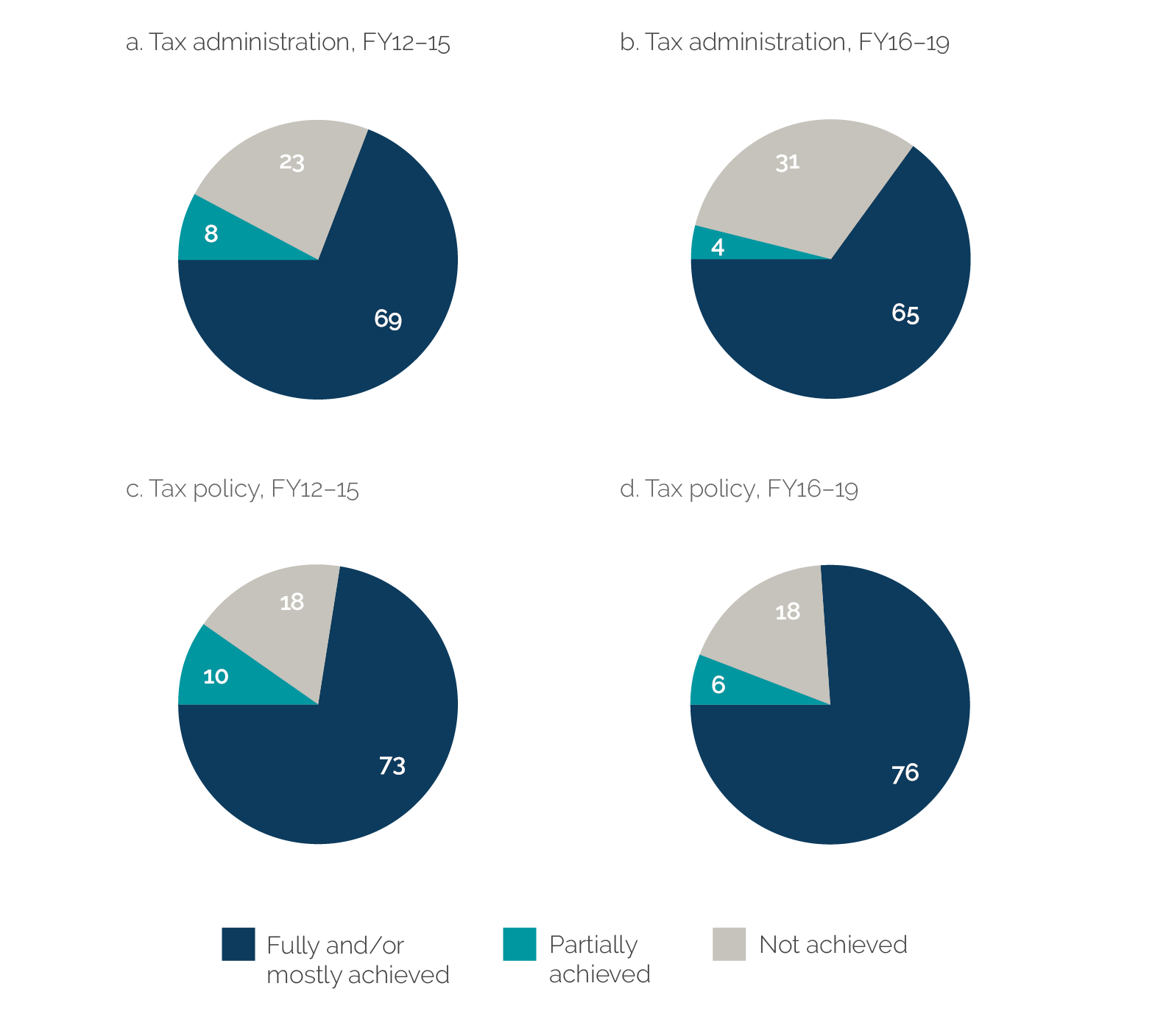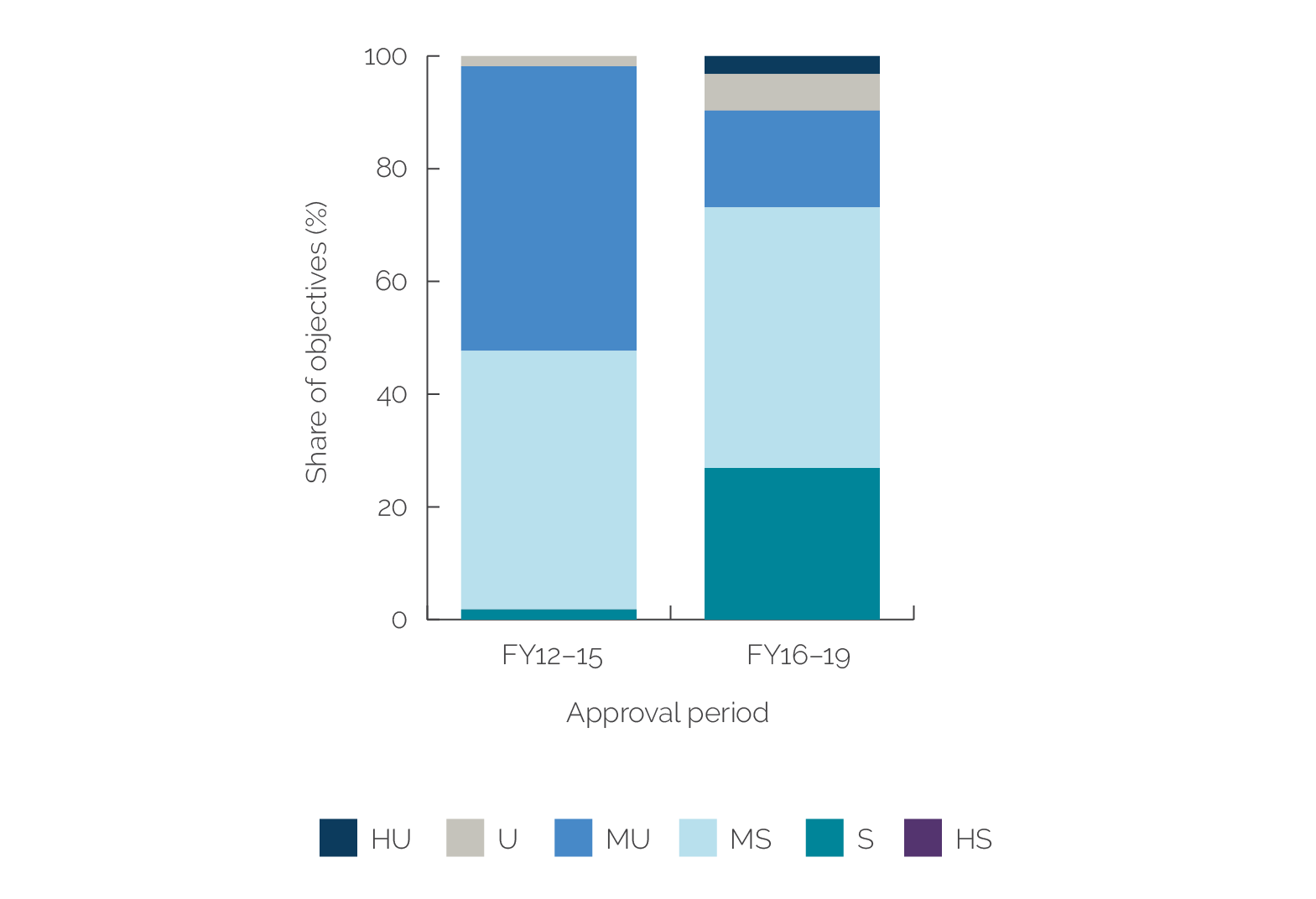World Bank Support for Domestic Revenue Mobilization
Chapter 3 | How Effective Was World Bank Support for Domestic Revenue Mobilization?
Results from investment projects supporting domestic revenue mobilization (DRM) were generally favorable. The share of projects rated satisfactory was 41 percent, with 35 percent of projects rated moderately satisfactory. Performance was generally better for tax administration projects in non–International Development Association–eligible countries than in International Development Association–eligible countries. Performance was rated poorly in one-quarter of cases, attributed to overambitious results indicator targets and challenging contexts, including in countries facing fragility, conflict, and violence.
Development policy operations (DPOs) showed a marked improvement in achievement of DRM-related objectives, although the results indicators used to measure impact were often inadequate. Those indicators were often too high level and did not adequately capture either the impact of prior actions or progress toward objectives.
Case study analysis suggests that tax policy reforms supported by DPOs were often reversed under pressure from vested interests. Project documents usually flagged risks from vested interests (with varying degrees of specificity), but without sufficiently concrete mitigating measures, risks often materialized. Although informed risk taking should not be discouraged, this suggests that prior actions should be designed with an aim of making their reversal more difficult.
Bank performance was rated satisfactory for two-fifths of all DRM-related investment projects and one in five DPOs with at least one DRM-related prior action. Bank performance for three-quarters of investment projects and DPOs was rated moderately satisfactory or higher.
Staff self-evaluations of operations and projects yielded few DRM-related lessons, and those were insufficiently specific. Only 3 of 60 closed operations and projects that were focused on DRM had DRM-specific lessons. The relative absence of DRM-related lessons at the project or operation level (in Implementation Completion and Results Reports and their validations) suggests scope for greater attention to learning from DRM-focused projects and operations.
This chapter reviews the effectiveness of DRM interventions based on evidence from Implementation Completion and Results Report Reviews, semistructured interviews, seven in-depth country case studies (Chad, Colombia, Guatemala, Kenya, Madagascar, Pakistan, and Rwanda), and IEG evaluations and validations of projects and operations with significant DRM content.1
Performance of Domestic Revenue Mobilization–Related Investment Projects
Results from investment projects supporting DRM were generally favorable. The share of investment projects rated satisfactory was 41 percent, with 35 percent rated moderately satisfactory. Twenty-two DRM-related investment projects closed during the evaluation period. IEG validated the ratings of three-quarters of those. DRM-related investment projects were more likely to have satisfactory outcome ratings than other World Bank investment projects (table 3.1). On average, performance was better for tax administration projects in IDA-eligible countries than in non-IDA-eligible countries (figure 3.1). Eighty-six percent of DRM investment projects in IDA-eligible countries were rated moderately satisfactory or higher versus 67 percent for projects in non-IDA-eligible countries, but a higher share of non-IDA projects was rated satisfactory (44 percent) compared with 29 percent for projects in IDA-eligible countries.2
Table 3.1. Independent Evaluation Group Outcome Ratings of Domestic Revenue Mobilization–Related Investment Projects, FY16–19
|
IEG Outcome Ratings |
Share of DRM-Related IPF (%) |
Share of Non-DRM IPF (%) |
|
Highly satisfactory |
0 |
3 |
|
Satisfactory |
41 |
32 |
|
Moderately satisfactory |
35 |
42 |
|
Moderately satisfactory or above |
76 |
78 |
|
Moderately unsatisfactory |
12 |
12 |
|
Unsatisfactory |
12 |
7 |
|
Highly unsatisfactory |
0 |
2 |
|
Moderately unsatisfactory or below |
24 |
22 |
|
Total |
100 |
100 |
Source: Independent Evaluation Group DataMart, April 2021.
Note: DRM = domestic revenue mobilization; FY = fiscal year; IEG = Independent Evaluation Group; IPF = investment project financing.
Figure 3.1. Outcome Ratings for Domestic Revenue Mobilization–Related Investment Projects in IDA-Eligible and Non-IDA-Eligible Countries, FY16–19
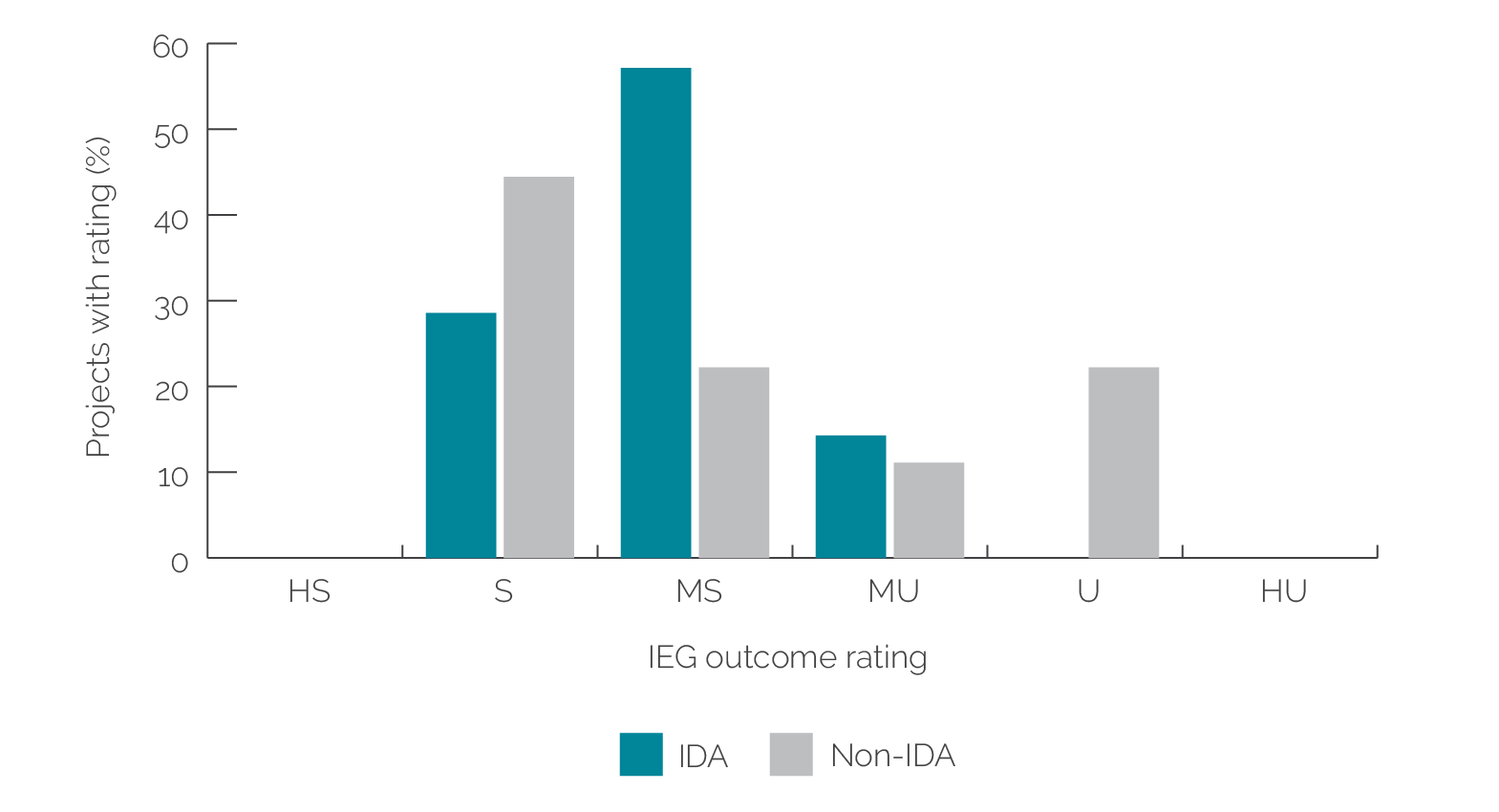
Source: Independent Evaluation Group DataMart database, May 2021.
Note: FY = fiscal year; HS = highly satisfactory; HU = highly unsatisfactory; IDA = International Development Association; IEG = Independent Evaluation Group; MS = moderately satisfactory; MU = moderately unsatisfactory; S = satisfactory; U = unsatisfactory.
Performance of Development Policy Operations with Domestic Revenue Mobilization–Related Prior Actions
Achievement of Targets for Domestic Revenue Mobilization–Related Results Indicators
Targets for a significant majority of DRM-related results indicators in DPOs approved during the evaluation period were at least mostly achieved. IEG rated four-fifths of DRM-related DPOs approved during the evaluation period. Targets for 70 percent of DRM-related results indicators were fully or mostly achieved, similar to the share in the previous three-year period, although the share of indicators that were not achieved in the evaluation period increased modestly (figure 3.2). Performance of results indicators related to tax policy reforms was better than for tax administration reforms both in the evaluation period and in the earlier three-year period (figure 3.3). However, case study evidence suggests that these results were often not sustained after operations were closed.3
Figure 3.2. Achievement of Targets for Domestic Revenue Mobilization–Related Results Indicators
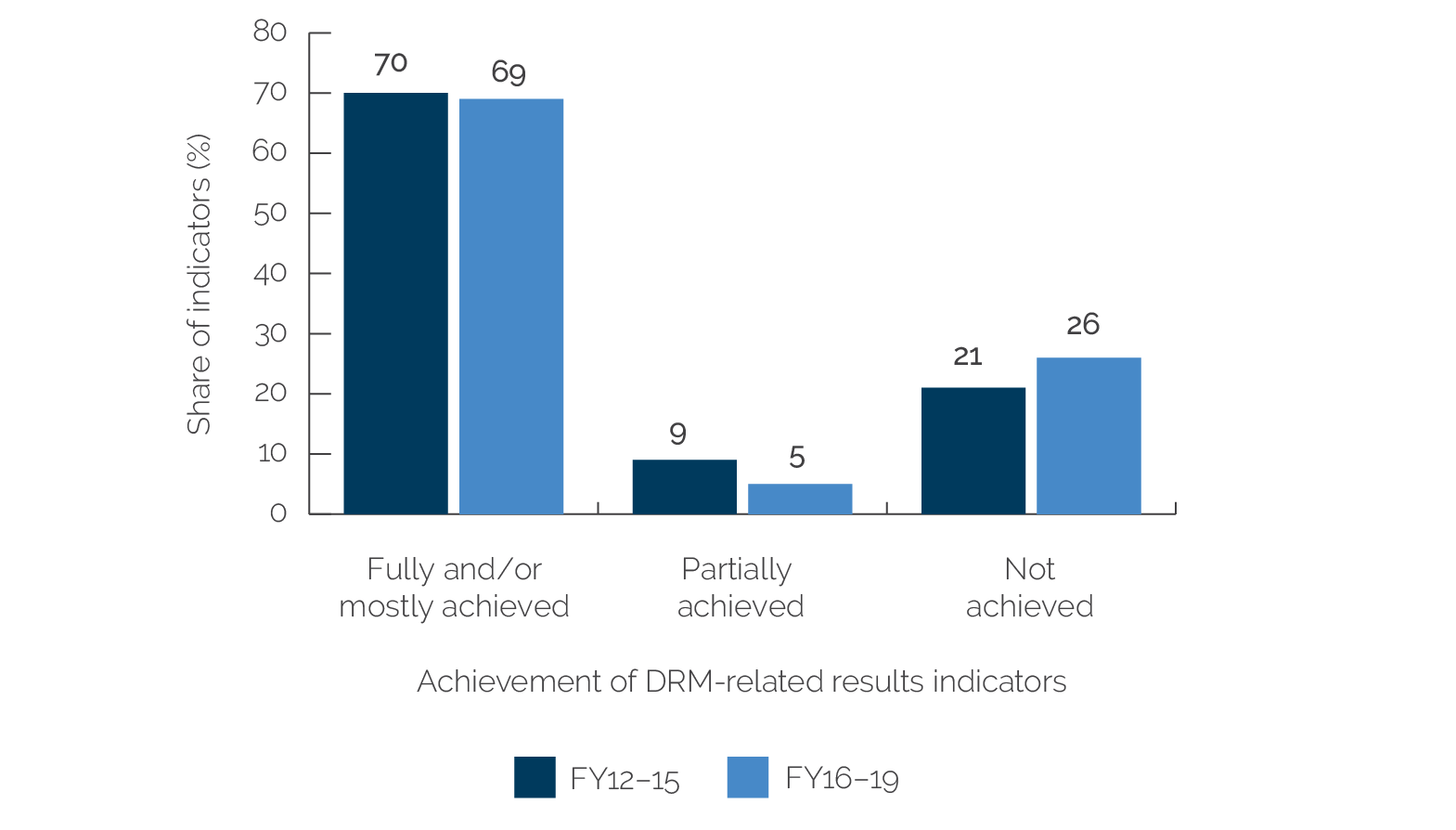
Source: Independent Evaluation Group Implementation Completion and Results Report Review database, August 2022.
Note: DRM = domestic revenue mobilization; FY = fiscal year.
Figure 3.3. Achievement of Domestic Revenue Mobilization–Related Targets by Theme (percent)

Source: Independent Evaluation Group Implementation Completion and Results Report Review database, August 2022.
Note: FY = fiscal year.
The achievement of DRM-related objectives in DPOs improved significantly in the evaluation period (compared with the previous period). Figure 3.4 shows significant increases in the shares of objectives rated satisfactory (from 2 percent over FY12–15 to 27 percent over the evaluation period). The share of objectives with achievement rated moderately unsatisfactory or lower was reduced by half between the two periods.
Figure 3.4. Efficacy Rating for Domestic Revenue Mobilization–Related Objectives in Development Policy Operations
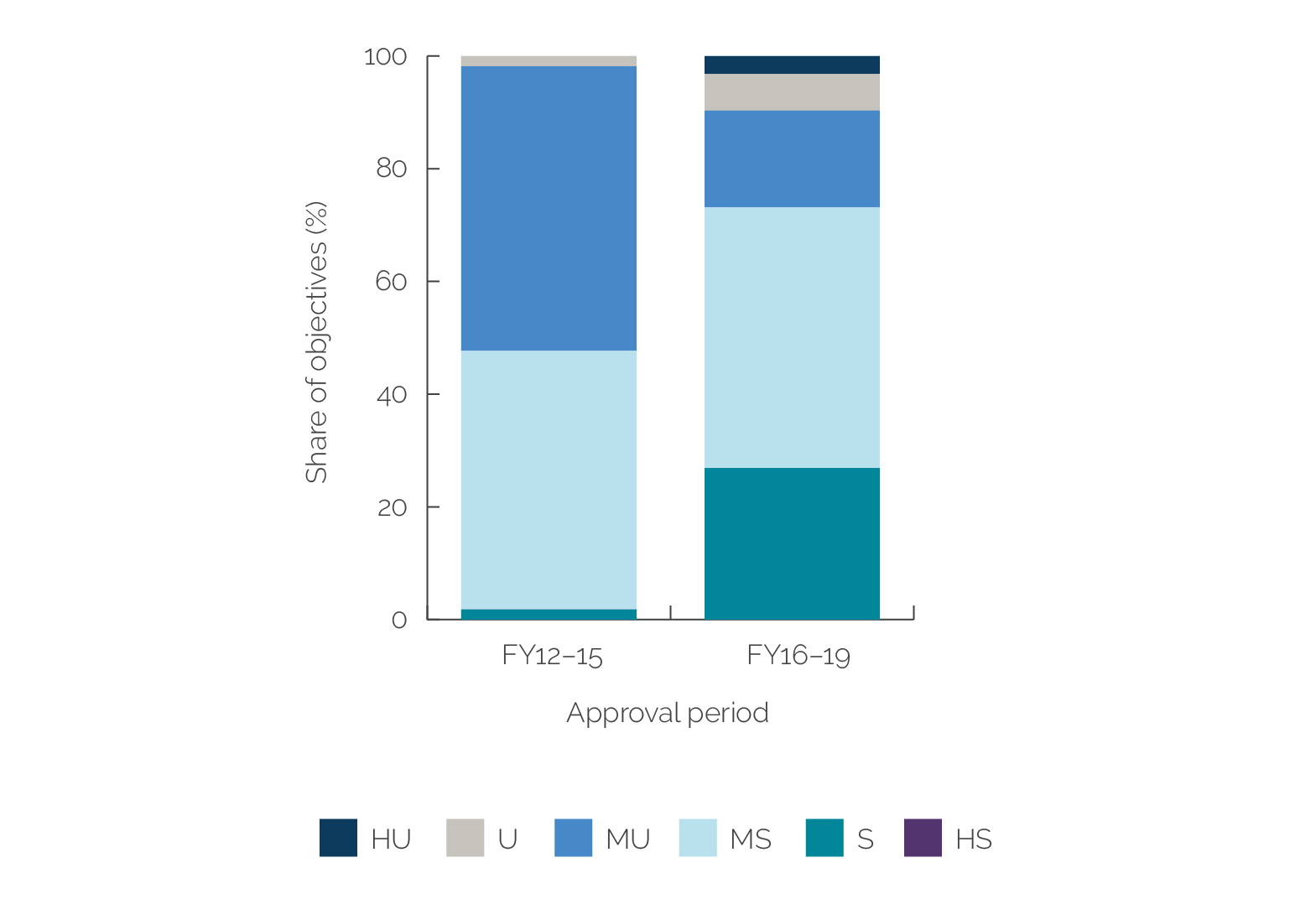
Source: Independent Evaluation Group Implementation Completion and Results Report Review database, August 2022.
Note: FY = fiscal year; HS = highly satisfactory; HU = highly unsatisfactory; MS = moderately satisfactory; MU = moderately unsatisfactory; S = satisfactory; U = unsatisfactory.
Bank Performance Ratings and Lessons from Projects and Operations
Bank performance was rated satisfactory for two-fifths of all DRM-related investment projects and moderately satisfactory or higher in three-quarters of investment projects. About one-quarter of investment projects were rated moderately unsatisfactory or lower (figure 3.5).
Figure 3.5. Bank Performance Ratings for Domestic Revenue Mobilization–Related Investment Projects, FY16–19

Source: World Bank Business Intelligence database, April 2021.
Note: FY = fiscal year.
Only 3 of 60 Implementation Completion and Results Report Reviews of DRM-related projects and DPOs had lessons that addressed DRM explicitly. All were for operations in IDA-eligible countries. These lessons were as follows:
- The need for sustained focus on tax administration improvements, which may lead to improved compliance in fragility, conflict, and violence setting (Burkina Faso)
- The need for political economy analysis and political support to avoid reversal of difficult tax-related policy reforms; technical assistance can also help (Guinea)
- The importance of collaboration with the IMF and coordination with IMF technical assistance on DRM issues (Madagascar)
- The findings of in-depth evaluations of six DRM-related projects and operations are described in domestic revenue mobilization Evaluation Insight Note (World Bank 2023). This note contains a detailed review of six Independent Evaluation Group Project Performance Assessment Reports. The underlying interventions were selected from among closed operations with significant DRM content, covering a diverse group of countries. Performance ratings (which the Independent Evaluation Group assigns independently) were not considered in the selection process. The interventions assessed were from five countries—Croatia, Guatemala, Liberia, Pakistan, and Panama—and one state, Rio de Janeiro in Brazil. The International Bank for Reconstruction and Development financed four of the interventions, the International Development Association financed one, and one used a blend of concessional and nonconcessional World Bank financing.
- The World Bank supported 12 DRM-related investment projects in 11 of 39 countries facing fragility, conflict, and violence over the evaluation period. Only 1 project had closed and had its rating validated by the Independent Evaluation Group (Liberia), too few to draw meaningful conclusions.
- Achievement was gauged at the country level using results indicators in country strategies and interventions. Also, broader indicators (for example, ratio of revenue to GDP in low-income countries and other indicators of revenue performance) were used to gauge outcomes in groups of countries, compared with long-term averages before the evaluation period (before 2016). At the intervention levels, evaluative evidence from Implementation Completion and Results Report Reviews, Project Performance Assessment Reports, and reviews of ongoing operations was used and combined with additional evidence from semistructured interviews of stakeholders at the corporate, development partner, and country client and staff levels.




